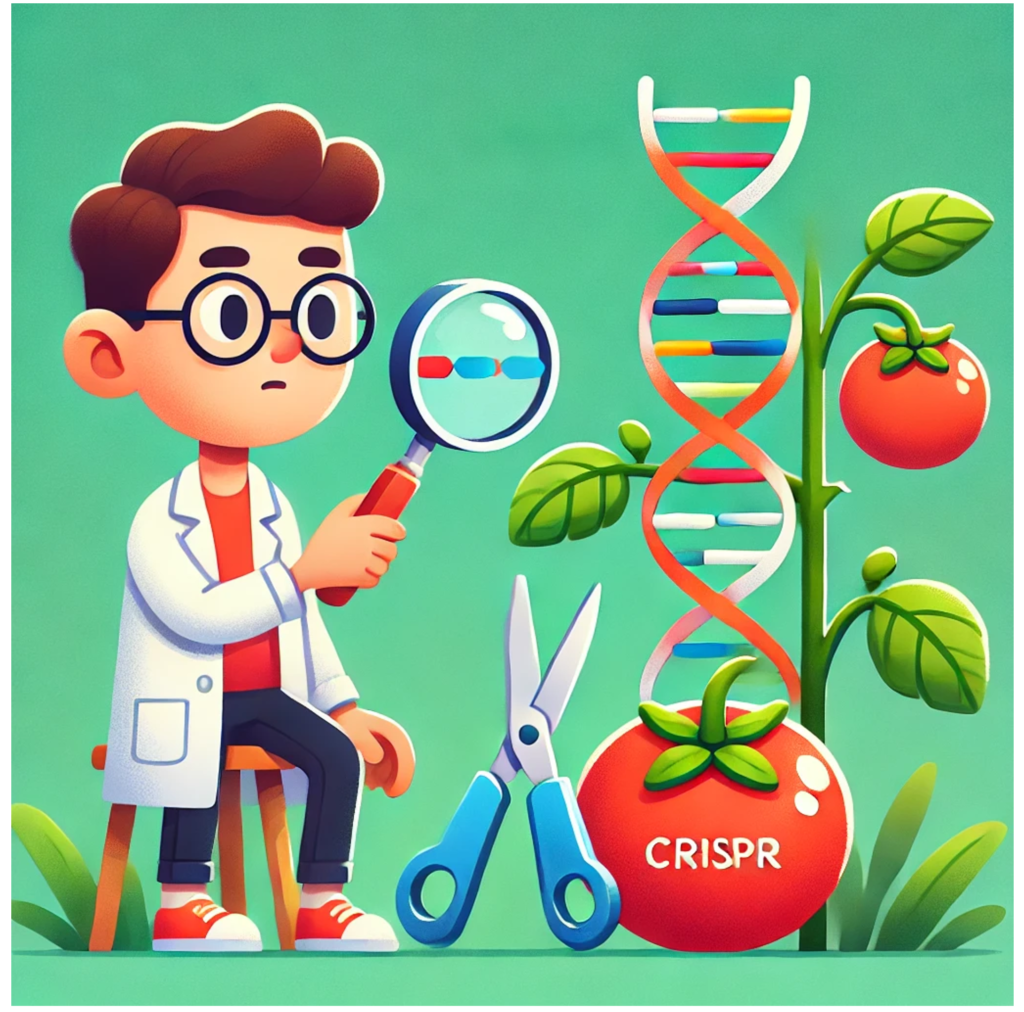
Image: Cartoon of a scientist studying a tomato plant using CRISPR technology. Credit: OpenAI (2024), DALL-E.
Imagine strolling through a garden full of vibrant plants, where tomato plants are bearing ripe, juicy fruit. Now, think of each tomato plant not just as a provider of delicious tomatoes, but as a living code—where every bit of DNA controls how it grows, resists disease, and produces fruit. What if you could tweak that code to create a tomato plant that’s hardier, more productive, and even tastier? Thanks to CRISPR gene knockin technology, this idea is becoming a reality, giving us the tools to fine-tune plants in ways that once seemed impossible.
Welcome to the world where plant science meets cutting-edge genetics. CRISPR-based gene knockin is the tool that allows us to not just deactivate certain genes, but to replace them with superior, synthetic versions. From creating disease-resistant crops to improving yield, CRISPR has the potential to revolutionize agriculture, and in this blog, we’ll explore how this groundbreaking technology works and what it means for the future of farming.
What Exactly is CRISPR?
Before we delve into the specifics of gene knockin, it’s essential to understand the basics of CRISPR. CRISPR, short for Clustered Regularly Interspaced Short Palindromic Repeats, was first discovered as part of a bacterial immune system. Think of it as bacteria’s built-in defense mechanism. When viruses attack, bacteria use CRISPR as a genetic “spellchecker,” detecting and cutting out viral DNA to protect themselves.
Now, fast forward to today, and scientists have adapted this system for use in plant and animal genetics. By utilizing a guide RNA (a small RNA sequence that acts like a GPS system) and the Cas9 protein (which works like molecular scissors), scientists can now target specific spots on a DNA strand. This allows them to cut, edit, or replace DNA sequences with unparalleled precision. It’s like being able to revise specific chapters in a book, correcting errors or even adding new, exciting content.
Evolution of CRISPR: From Deactivation to Knockin
CRISPR technology has come a long way since its initial discovery. While it was originally used to deactivate genes—essentially turning off the unwanted sections of DNA—scientists have since pushed the envelope further. Now, the focus is on gene replacement, or “knockin,” where a natural gene is swapped out for a synthetic, improved version. Imagine replacing an outdated engine in a car with a high-performance one. This is precisely what gene knockin accomplishes at a molecular level.
So why is this so revolutionary? With gene knockin, we are not just silencing undesirable traits in plants but actively replacing them with better, more efficient versions of those genes. For example, if a wild tomato variety has a gene that makes it branch more, resulting in more tomatoes, we can insert this gene into a cultivated variety that already has other desirable traits. The result? More tomatoes, better disease resistance, or even increased tolerance to heat or drought.
The Challenge of Gene Knockin in Plants
While CRISPR is a highly efficient tool, there are some challenges—particularly when it comes to integrating new genes into plant DNA. Unlike bacteria, plant cells are not naturally inclined to accept foreign DNA. This resistance makes it tricky to introduce new genes.
To overcome this, scientists developed a clever solution by modifying the Cas9 protein. By attaching an enzyme called exonuclease (derived from viruses), they can significantly increase the success rate of gene integration. Think of this as boosting the efficiency of your molecular scissors, ensuring that the new synthetic gene becomes part of the plant’s DNA.
How CRISPR Gene Knockin Can Transform Agriculture?
Now, let’s get back to the tomato plant in your garden. Using CRISPR-based gene knockin, scientists could take a gene from a wild tomato variety that naturally produces more branches and fruits and insert it into a domesticated plant. This targeted editing allows you to cultivate a plant that produces more tomatoes than ever before, all thanks to the precise manipulation of its genetic code.
But it doesn’t stop there. CRISPR-based gene knockin can be used to:
- Enhance disease resistance: Plants can be modified to resist common pathogens, reducing the need for chemical pesticides.
- Increase heat and drought tolerance: In a world grappling with climate change, these modifications could allow crops to thrive in hotter, drier conditions.
- Improve water efficiency: Crops can be engineered to use water more efficiently, making them more sustainable and easier to grow in arid regions.
A Bright Future for CRISPR Gene Knockin
The possibilities with CRISPR gene knockin are truly endless. As scientists continue to refine this technology, we will likely see more robust crops that are better suited to the growing challenges of modern agriculture. Whether it’s through producing more food, reducing environmental impact, or ensuring that plants can withstand the stresses of a changing climate, CRISPR is at the forefront of agricultural innovation.
In conclusion, CRISPR-based gene knockin allows us to replace genes in plants with improved versions, giving us the power to craft crops that are stronger, healthier, and better suited to our needs. This revolutionary tool is opening up new doors in plant science, and it’s just the beginning.
So, next time you enjoy a fresh, juicy tomato, remember—you might just be tasting the future of farming, one gene at a time. Check out my other blog on gene knockout vs knockin pipeline here and stay tuned for more exciting insights into the incredible world of plant science!
References
- 1. Dong OX. Gene Replacement and Knockin Made Easy in Plants. Mol Plant. 2020 Aug 3;13(8):1104. doi: 10.1016/j.molp.2020.07.015. Epub 2020 Jul 22. PMCID: PMC7374131
- 2. Tom Schreiber, Anja Prange, Petra Schäfer, Thomas Iwen, Ramona Grützner, Sylvestre Marillonnet, Aurélie Lepage, Marie Javelle, Wyatt Paul, Alain Tissier, Efficient scar-free knock-ins of several kilobases in plants by engineered CRISPR-Cas endonucleases, Molecular Plant, Volume 17, Issue 5, 2024, Pages 824-837, ISSN 1674-2052, https://doi.org/10.1016/j.molp.2024.03.013.

Pingback: CRISPR Gene Knockout vs. Knockin: Understanding the Pipeline – plantsdecoded.com